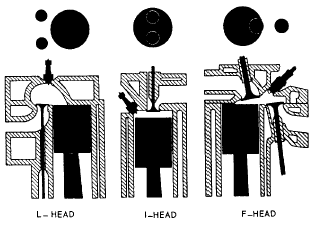ARRANGEMENT OF CYLINDERS
Engines are also classified according to the arrange-ment of the cylinders. One classification is the in-line, in which all cylinders are cast in a straight line above the crankshaft, as in most trucks. Another is the V-type, in which two banks of cylinders are mounted in a "V" shape above the crankshaft, as in many passenger vehicles. Another not-so-common arrangement is the horizontally opposed engine whose cylinders mount in two side rows, each opposite a central crankshaft. Buses often have this type of engine.
The cylinders are numbered. The cylinder nearest the front of an in-line engine is numbered 1. The others are numbered 2, 3,4, and so forth, from the front to rear. In V-type engines the numbering sequence varies with the manufacturer.
The firing order (which is different from the numbering order) of the cylinders is usually stamped on the cylinder block or on the manufacturer’s nameplate.
VALVE ARRANGEMENT
The majority of internal combustion engines also are classified according to the position and arrangement of the intake and exhaust valves. This classification depends on whether the valves are in the cylinder block or in the cylinder head. Various arrangements have been used; the most common are the L-head, I-head, and F-head (fig. 12-8). The letter designation is used because the shape of the combustion chamber resembles the form of the letter identifying it.
L-Head
In the L-head engines, both valves are placed in the block on the same side of the cylinder. The valve-operating mechanism is located directly below the valves, and one camshaft actuates both the intake and exhaust valves.

.
-L-, I-, and F-valve arrangement.
I-Head
Engines using the I-head construction are called valve-in-head or overhead valve engines, because the valves mount in a cylinder head above the cylinder. This arrangement requires a tappet, a push rod, and a rocker arm above the cylinder to reverse the direction of the valve movement. Only one camshaft is required for both valves. Some overhead valve engines make use of an overhead camshaft. This arrangement eliminates the long linkage between the camshaft and the valve.
F-Head
In the F-head engine, the intake valves normally are located in the head, while the exhaust valves are located in the engine block. This arrangement combines, in effect, the L-head and the I-head valve arrangements. The valves in the head are actuated from the camshaft through tappets, push rods, and rocker arms (I-head arrangement), while the valves in the block are actuated directly from the camshaft by tappets (L-head arrangement).